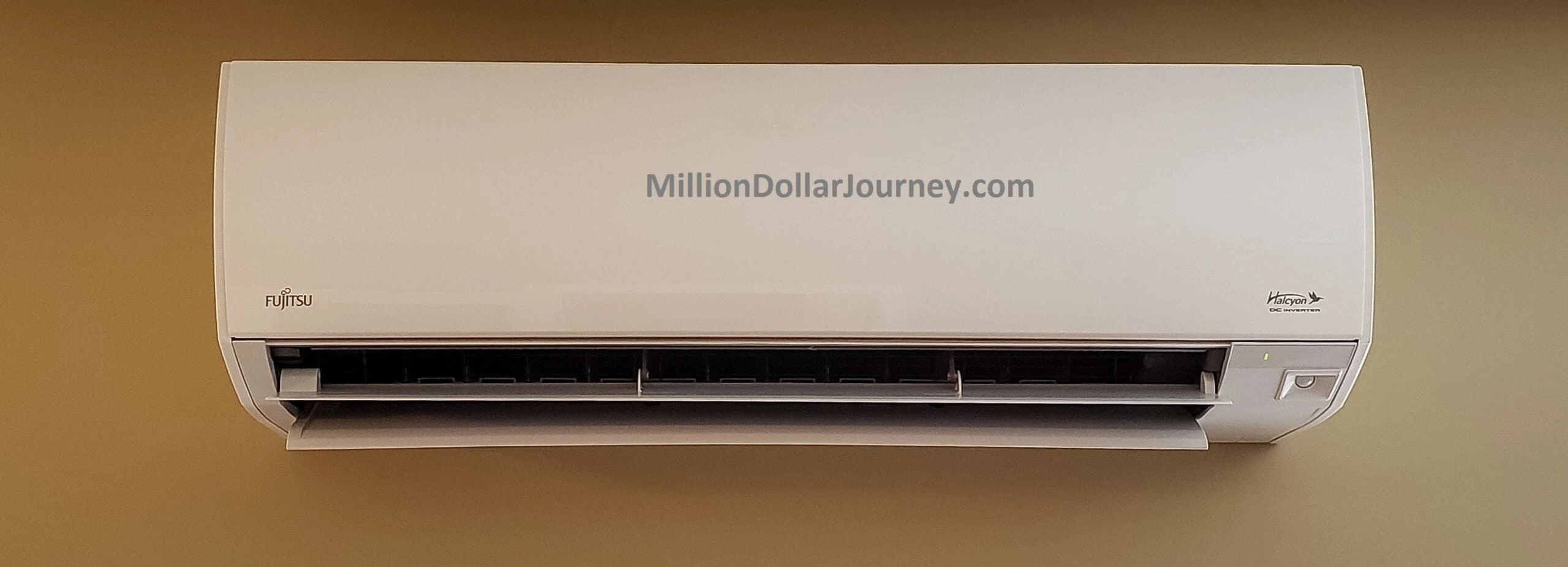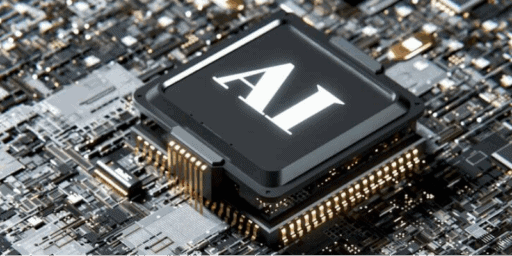The Mini-Split Heat Pump Experiment – Will it Save You Money?
Way back in 2008, we completed a custom home that we still live in today. In that same year, I wrote a post about my regrets of not going with a heat pump to save money on energy bills. I’m not sure if you use electric heat where you are from, but if you do, you’ll know that winter heating costs can really add up.
What is a Heat Pump?
A heat pump is a heating/cooling system for a home that works very similarly to your refrigerator. When it’s cold outside, it can efficiently extract the warmth out of the air, amplify it by compressing the refrigerant, and releasing the heat it into the home with a forced air system. What’s neat about a heat pump is that it can work in reverse and provide air conditioning inside the home during the warmer summer periods.
It’s quite costly to retrofit an existing home with a heat pump due to the additional ductwork required (unless you have a furnace with the ductwork already installed). Friends of ours recently retrofitted their home that is similar to ours and it cost about $20,000 for both the new ductwork, heat pump, and associated equipment.
$20,000 is a lot of money to spend on a heat pump retrofit and not quite worth it because it would take quite a while to pay off (if ever!). A worthy alternative to a full-size heat pump is a mini-split heat pump which has many of the benefits of a conventional heat pump but at a fraction of the cost. My kind of solution!
What is a Mini-Split Heat Pump?
Before I get into the merits of a mini-split – what exactly is it? It’s essentially a heat pump that has an outside unit and an inside register (like the picture above) that’s usually on an exterior wall.
In the winter, the units will extract any warmth in the air (will get less efficient the colder it gets), and expel it the inside of your home. In the summer, the AC will extract heat (and moisture) from the inside of your home and expel outside (while also blowing cold air inside). From my research and talking to people with mini-splits, the energy savings works out to be between 15%-35%
The beauty of mini-splits is that you do not need additional ductwork, but the downside is that it’s only meant to heat one space/room per unit. The ideal situation for a mini-split is an open concept area that is used as the main area in the house. Oh, and you’ll also need to wrap your head around the size of the inside register. Some of the biggest concerns are the “look” of the unit, which turns out to be not that big of a deal (at least to me!).
The Ideal User
I must admit that the mini-split technology has been good to us thus far (the numbers below), but mini-splits won’t benefit everyone the same. Here are the ideal scenarios for mini-split heat pumps:
- Your climate needs to be temperate where it doesn’t get too hot or too cold. Living in NL, I was more focused on the heating capabilities of the mini-split. Even though Newfoundland usually gets a ton of snow in the winter, ambient temperatures generally average between -5 and 0 Celsius. You can get mini splits that can function fairly well down to -25C (ambient), but note the closer it gets to -25C, the less efficient it will be. So if you live in Northern Ontario/Quebec, a heat pump may not be the most efficient solution. Also note that heat pump efficiency and operating temperature can vary widely from brand to brand, make sure to do your research!
- Open Concept Living – This style home works really well for mini-split heat pumps as it allows the air to fill the room without resistance of doorways etc. For us, we are fortunate in that the back of our house is an open concept which is where the mini-split was installed. We pointed the mini-split to face the foyer area with the intention of letting the hot air rise to the bedrooms. So far so good!
- Modern insulation. From reading power utility recommendations, insulation is your first defense against high heating bills, then your heating source comes in second. Check out your local utility for rebates around insulating your home. We built our house about 10 years ago, which was fine for insulation at the time. New building code requires additional attic insulation (R30 to R50) which I will look into over the next couple of years.
- Electric Heat – Let’s face it, using electric heat is an expensive way to heat your home. A small 4.5-ft baseboard heater uses about 1,000W. In our family room, the baseboard heater is closer to 8-ft, which uses 1,800W combined with a 1,500W fan heater in the kitchen. Combined with the kid’s rooms, the mini-split displaces about 5,500 W of electric baseboard heat energy in our home. Mind you, the electric heaters aren’t always on, but they are expensive to run when you need them. Compare this with a 16,000 BTU/h min-split that uses about 1,000 W of energy.
- Rising Utility Prices – While there can be energy savings with using a mini-split, the savings amplify if you are in a rising utility rate environment. A number of years ago, Newfoundland and Labrador decided to take on a large power generation project that has gone way over budget. Without getting into politics, it is anticipated that if the government does not step in with rate mitigation, electricity rates could reach as high as $0.23/kwh. The current rate including taxes is $0.132/kwh (that’s a 74% increase!).
Performance and Results
Let’s get down to the good stuff – the numbers! Has the mini-split purchase been worth it? When is the expected pay off? Enough talk, let’s dig in!
Before we get started about performance, let’s talk about the cost of the unit. I went with a Fujitsu Halycon XLTH unit due to its efficiency (among the best in the industry) and incredible warranty (10/12 years depending on your installer). I found a local certified company to supply and install the unit for $3,700 plus tax, or about $4,250 including tax. Note that the pricing includes a $200 rebate promotion offered at the time.
Being the type of guy that likes efficiency, we were already pretty efficient with our electric heat usage. We installed programmable thermostats, heating the basement to minimum requirements, leaving some rooms unheated, opening the blinds during sunny days etc. However, it always felt cold in the house. With the boss (my wife) spending more time at home, at the very least, the mini-split would make the house feel warmer.
Onto the performance table! The unit was installed in September 2018 and I have data up until January 2019. To explain the “normalized” column, I adjusted the usage based on the temperature difference between 2018 and 2019. The utility sent me an email stating that every 1C drop in temperature results in 10% greater electric heat usage. Since it’s been colder in 2019, I had to adjust 2018 numbers so that the comparison was on equal footing.
Energy Usage Comparison – Electric Heat vs Mini-Split
| Date | Electric (kWh) | Temperature Diff (C) | Normalized Electric (kWh) | Date | Mini Split (kWh) | Difference | Savings % |
| Sep 2017 | 915 | 0 | 915 | Sep 2018 | 1048 | -133 | -14.54% |
| Oct 2017 | 1132 | 0.05 | 1188.6 | Oct 2018 | 1096 | 92.6 | 7.79% |
| Nov 2017 | 1881 | 0.15 | 2163.15 | Nov 2018 | 1443 | 720.15 | 33.29% |
| Dec 2017 | 2787 | 0.2 | 3344.4 | Dec 2018 | 1903 | 1441.4 | 43.10% |
| Jan 2018 | 2548 | 0.15 | 2930.2 | Jan 2019 | 1784 | 1146.2 | 39.12% |
| Total: | 9263 | 10541.35 | 7274 | 3267.35 | 31.00% |
From Sept 2017 to Jan 2018, the electricity usage was around 10541.35kWh with electric heat being about 70% of the culprit. Fast forward to when the mini-split was installed, resulted in usage of 7274kWh which is a 31% savings thus far. I suspect that the savings percentage may decrease over the summer if we decide to use the AC functionality (most houses in NL do not have AC and for good reason!).
Payback Period
So here’s the point of the whole article – is a mini-split a good investment? Even though my experience thus far has been short, it’s a resounding yes for me. If we can average a 25% annual energy savings, the payback period is 6.39 years (based on using 20,000 kWh per year). The payback period gets shorter as electricity rates go up. Here is what that looks like:
| Price per kWh | Savings | Years Pay Off |
| $0.133 | 25.00% | 6.39 |
| $0.150 | 25.00% | 5.67 |
| $0.170 | 25.00% | 5.00 |
| $0.200 | 25.00% | 4.25 |
| $0.220 | 25.00% | 3.86 |
Final Thoughts
As you can see, I am all for mini-split technology providing that it suits your house and area. For us, it will result in about a 25% annual energy savings which results in a 6.4-year pay off period at current electricity rates. As rates rise (as they are expected in NL), the dollar savings will increase, which will further reduce the payback period. A warmer house at a lower price – what more can you ask for?
I've Completed My Million Dollar Journey. Let Me Guide You Through Yours!
Sign up below to get a copy of our free eBook: Can I Retire Yet?











I am thinking about putting a ductless unit in my basement as I spend most of my time there. House is currently heated with forced air natural gas.
Thinking as I spend most of my time in the basement I can set the rest of the house to give minimal heat and AC from the current furnace. Wondering if I am maybe better off just getting a good space heater for the basement instead of spending the money. Not sure if I will recover the cost. Any thoughts
I installed a 36000 BTU tri zone( 3 indoor heads) in my 3year old home which is well insulated and located near Vancouver British Columbia. The first year I heated the home with baseboard heaters and the next year I used only the mini split heat pump. For December and January I spent $95. per month to heat 2600 sq . ft which compared to the previous electric heat year was a 49% savings. I installed it myself for a cost of approximately $4000 so it’s paid back in about 4 years from the energy savings. The savings only get better the rest of the heating season because the efficiency of the mini splits only increases with the warmer temperatures where base board heaters remain constant.
Just wondering if you had looked the numbers again now that you are a full year in. Thanks.
Hi Neil!
Yes, I tracked for 1 full year and it worked out to be 30% savings year/year. Since we were fairly efficient before, the estimated payback is about 5 years for us.
The 30% savings you are seeing is that on your whole bill or just the heating portion? From a couple sites I have been looking on they suggest that home heating comprises somewhere between 70 and 75% of your electrical bill.
Your electric rates are ridiculous!
Rates out here (AB) could be 1/2 to a 1/4 of that. And it’s not just coal, the new solar PV plants coming on line were competitively bid at under 2c/kwh wholesale.
People use the heat pumps here for whole house heat/cool in superinsulated houses. They won’t be the wall mount mini splits, but the whole house fancoils that install in a furnace frame. Requires the ductwork. With the whole house ventilation requirements of our new building code, ductwork is pretty much required. I’d consider the smaller wall mount mini splits for detached garages/suites, or a cottage.
No argument there and the rates are only going to get worse here!
We run 2 Fujitsu mini-splits to do our whole house (all electric). It is an above average size super-insulated passive house in NS. Our electric bill for 2 months (Dec 2018 and Jan 2019) was 2688 kWh. We have baseboards for back-up which helps if guests want to crank the heat in their bedroom for comfort. Otherwise, the baseboards are set to 10C and never come on.
cjay, do you have usage numbers before you installed the fujitsu mini splitss?
I have two of these for air conditioning and supplemental heat in addition to radiant hot water floor heating in my 3,300 sf post and beam home. They are quiet, efficient and give us great air conditioning and humidity reduction in a house with no forced air ducts. We don’t use them much for heat but in the spring and fall they are great when we don’t want to use the in floor heating.
I highly recommend you look at Sensibo wifi controls which along with the smart phone app allow you to control the unit remotely, see current indoor temperature and humidity levels and even set up geofencing to turn units on or off automatically based on your physical location. I got mine on amazon.ca
Thanks for sharing! The cost information is great! We don’t have the right duct work (or any we have rads) so the mini unit might work for us. I will have to rebudget it with your energy use savings!
I won a heat pump from my electric utility. I can’t do apples-to-apples on savings because my occupant load changed right before I got the heat pump, but there’s no doubt it’s saving on my monthly bill. With an initial cost of $0, my payback was instant :)
Money aside, I’ve actually found the nicest thing about it is the AC. I don’t use it heavily (not super necessary in NS), but I use it enough to allow me to close windows on hot summer days. This is a huge quality of life increase because I live in a downtown area with lots of street noise.
Good one Ian, never thought about the benefits of keeping the windows closed in busier areas. What brand mini-split did you win?
I won a Fujitsu. It’s been great; no issues with it moving heat in the temperatures we get in NS.
I went with a floor unit for the interior head rather than a wall unit. It looks kind of like a radiator. I’m in a heritage building with low ceilings so I felt like it fit better in the space.
Heat Pump (in Canada sometimes aka Geothermal energy) is a machine that moves heat from one location to another location using mechanical work. Common examples are refrigerators and freezers, air conditioners etc.
The term coefficient of performance (COP) is used to describe the ratio of useful heat to the input.
The COP of a heat pump is specified at a temperature of 35 Kelvin, aka difference (inlet-outlet) of 35°C and is for an air-source heat pump typical 3 (@ 35K), for a ground source or geothermal HP approx 4. As bigger the temperature difference as lower the COP, see graph.
In Canada air to air Heat pumps are on the market. The inlet air temperature of a forced air heating system is approx 50°C. At outside temperatures below 0°C, the COP is 1, therefore a standard electric heating system is at this time more efficient and way cheaper.
HP working to big surfaced floor or wall house heating system, where the inlet temperature (water) is 25 to max 38°C, makes better sense. A ground source / “geothermal” to water Heat-Pump together with an efficient floor or wall heating system may reach a COP of 5.
Means: With 1 kWh Electricity, 5 kWh heat is generated.
Therefore the fuel costs are: < 2 cts/kWh, about half of Natural Gas
The investment is high approx 30’000 to 40’000 CAD
The comfort is high: No noise and a healthy, evenly warm house.
Picture: A heat pump's vapor-compression refrigeration cycle: 1) condenser, 2) expansion valve, 3) evaporator, 4) compressor.